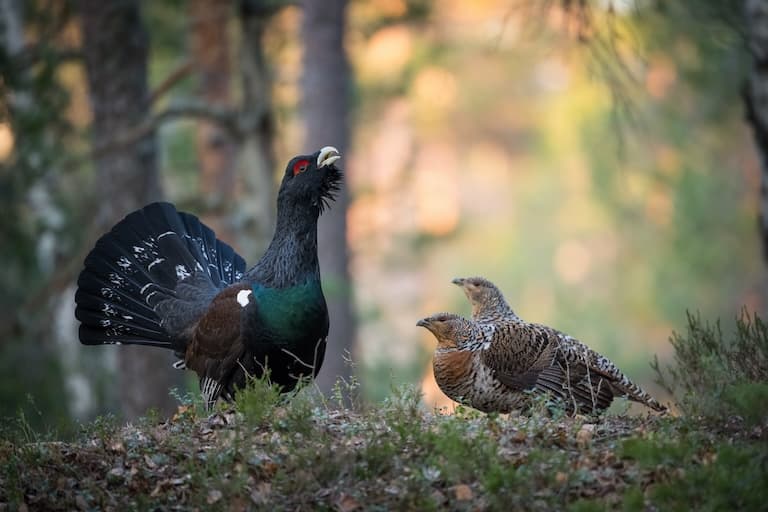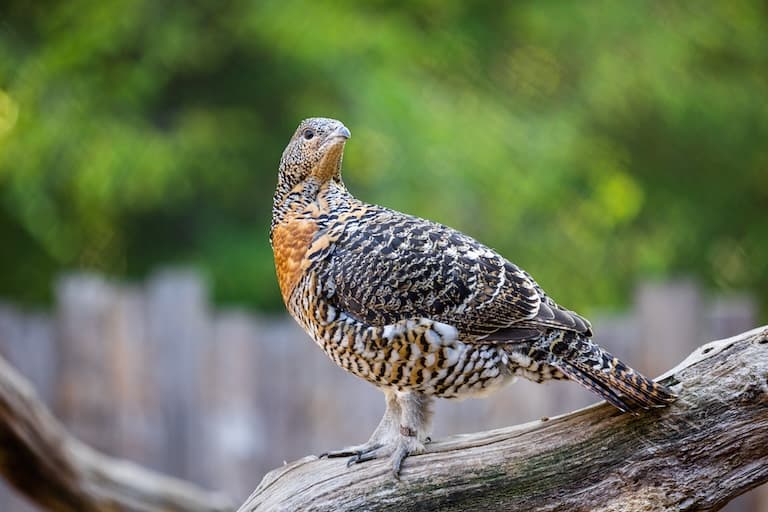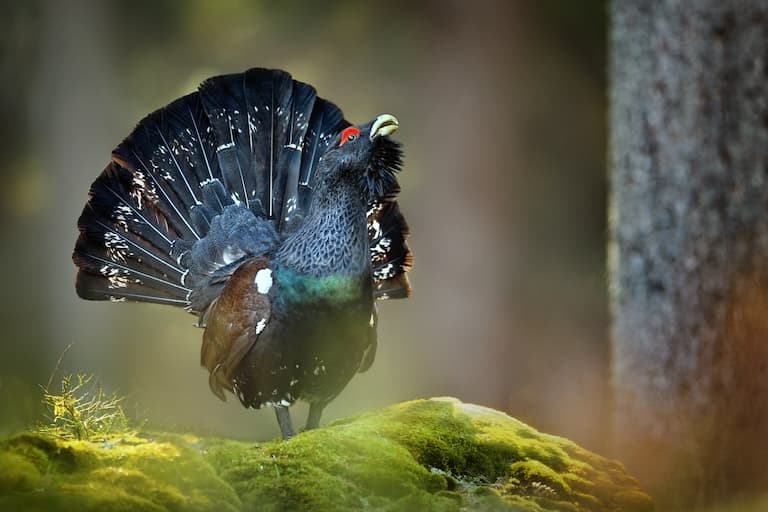Capercaillie Profile
The advancement of human societies and the rapid modernisation of our habitations seem to correlate inversely with a familiarity with the wildlife that once surrounded us.
In Europe, much of this wildlife now only exists “outside”: far from the cities and sometimes in remote places that few people have an interest in visiting.
Animals like the Capercaillie, a heavy and charismatic relative of the pheasant, are still tremendously widespread in Eurasia, but remain unfamiliar to most urbanites, and even to science as a whole.
This so-called “Horse of the woodland” is represented in old traditions, and even its name, from old Scottish Gaelic, reflects a time when this wasn’t the case.

Capercaillie Facts Overview
| Habitat: | Forest, shrubland |
| Location: | Eurasia |
| Lifespan: | 18 years in captivity, around 4 years in the wild |
| Size: | Up to 86 cm (34 in) long |
| Weight: | Up to 6.5 kg (14 lb) |
| Colour: | Ranging from all black to all white, with spotted patterns along this spectrum. Green chest and red eye feathers in males. |
| Diet: | Pine needles, leaves, stems and berries of a variety of plants; insects |
| Predators: | Foxes, bears, mustelids |
| Top Speed: | Not stated |
| No. of Species: | 2 |
| Conservation Status: | Both are Least Concern |
The Capercaillies, a genus of just two species of Eurasian grouse, have a long history of forest life on the landmass, an area that was once covered in forest and has been stripped over the course of human agricultural history.
But some iconic species, this one included, could act as an effective lever of conservation efforts, functioning as an “umbrella” species for forest protection as a whole.
Interesting Capercaillie Facts
1. They’re Grouses
The Phasianidae family is known for its heavy, ground-based birds found all over the world. Some of the best-known birds are in this family, including chickens, turkeys and (obviously) pheasants.
Grouse were once considered members of their own family, Tetraonidae, but have since been grouped in Phasianidae as their relationships become a little clearer. They are now considered a tribe within the pheasant subfamily Phasianinae, which also contains peacocks and turkeys.
Peacocks are in a different tribe, and there is an ongoing and truly riveting discussion about whether or not turkeys belong in the grouse tribe. However, this conversation is so exciting that we won’t go into it here in case you forget to show up for work.
The grouse tribe is made up of some very good-looking birds, and they are typically found in temperate and subarctic regions of the Northern Hemisphere.
Two of them are the Capercaillies, defined by the genus Tetrao, and these are the Western, or Eurasian Capercaillie and the Eastern or, Black-billed Capercaillie.

2. One is widespread
If we risk the notorious wrath of a subgroup of bird taxonomists and disregard turkeys, the Western capercaillie is the largest of all the grouse species.
The heaviest recorded was 7.2 kg, and would have necessarily been a male since males are significantly larger than females. The Western capercaillie is the better-known of the two species, being significantly more widespread, though its habitats are known to be shrinking.
3. The other is more secretive
That leaves us with the black-billed capercaillie, which is also pretty large, and closely related enough to the Western capercaillie that hybrids are known to occur where their ranges overlap.
But the range of this species is significantly smaller, and it’s restricted to some of the remotest habitats in Europe, such as the taiga forests of eastern Siberia and the plains of Mongolia.
This latter habitat is one that the Western capercaillie tends to avoid, which makes the black-billed capercaillie much more adapted to open areas than its closest relative.
And this is the likely reason for the speciation of the two birds: the black-billed capercaillie avoids denser forests while the Western capercaillie avoids open plains, allowing both species to divide resources between them without competing.
4. They become vegetarian as they age
The vast pine forests present a year-round canopy cover in Arctic Europe, and combined with the layers upon layers of needles dropped from the trees, this means there’s not so much understory.
Luckily, the Western capercaillie gets by just fine on pine needles, especially during the winter when that’s about all there is to eat.
Summertime brings more variety, but the majority of the adult bird’s diet is plant-based. Young birds spend more time hunting insects while the high protein is useful to their growth but shows a dramatic shift as they age towards more cruelty-free options.
There is substantially less information on the dietary habits of the black-billed capercaillie but it looks as though it follows a similar pattern. 1 2

5. They Lek
When breeding, male capercaillies will carve out a space to put on a display of vigour and hope to use this to engage with as many females as possible.
Display grounds are arenas of great competition for males, and females will prefer the most dominant, but this is a somewhat secretive ceremony due to its location in some of the oldest parts of the forest.
As such, there are conflicting reports, some suggesting that these arenas are used for generations over hundreds of years, and others claiming that young forests are perfectly suitable, too.
It’s likely that both are right, but regardless, the males’ displays begin with loud singing and a noisy, drumming flight that’s more like a flapping jump. Fanned tails, extended necks, and other sexy postures are all designed to advertise the male’s fertility, and when one succeeds, he may
Males who win the affection of the females are allowed to copulate uninterrupted by the competition and may hold the rank for several years before it’s challenged. But when it is, it’s challenged with a belch-off.
6. The Belching Cantus
If we assume that “Cantus” is Latin for “singing”, and “belching” is Latin for “belching”, this describes accurately the approach that rival males have to competition.
Territory defence is as ritualised as mating is, but the dance is more aggressive. Neck feathers get all fluffed up and males will stand beak-to-beak. From here, they’ll engage in the “belching cantus”, a guttural sound of aggression, and if burping at one another doesn’t work, pecking might ensue until one or the other retreats.
The sounds that come out of these birds in both mating and fighting contexts are really quite special to hear and include clicking, creaking, grunting and drumming, depending on the context. 3
7. They’re in decline
In Scotland, the Western capercaillie is prone to getting stuck in fences. In Central Europe, ski resorts are interfering with their habitats, both by converting their mating and feeding grounds and scaring the birds away.
Diverse, species-rich European forests are being converted into economically preferable, single-species lots, and this is also contributing to the decline of the species.
The reduction in large predators may play a role, too, as the mesopredator release hypothesis suggests an increase of medium-sized predators in their absence might affect the ecological balance. 4

8. Saving them could save others
But a good Capercaillie conservation campaign could have a wealth of benefits that extend beyond the species itself.
Many of the actions needed to protect these birds will have an “umbrella” effect over the entire ecosystem, and this makes the Capercaillie a so-called “umbrella species”.
Umbrella species are appealing to foresters because they are a gateway to forest conservation. For example, protecting pandas, despite their every effort to go extinct, requires that vast amounts of bamboo forest are maintained.
Pandas are also cute and appealing enough to be a mascot for the WWF, so they can generate money that equally endangered snakes or insects just won’t.
Similarly, the charismatic Capercaillie might be a significant contributor to the protection of the forests of Eurasia.
Capercaillie Fact-File Summary
Scientific Classification
| Kingdom: | Animalia |
| Phylum: | Chordata |
| Class: | Aves |
| Order: | Galliformes |
| Family: | Phasianidae |
| Genus: | Tetrao |
| Species: | urogallus, urogalloides |
Fact Sources & References
- “Black-billed Capercaillie”, Oiseaux Birds.
- Laurel Hill, “Tetrao urogallus western capercaillie”, Animal Diversity Web.
- From Field 2 StreamTV (2014), “Capercaillie Attack!”, YouTube.
- ROBERT MOSS (2008), “Capercaillie Tetrao urogallus in Scotland – demography of a declining population”, Wiley Online Library.
